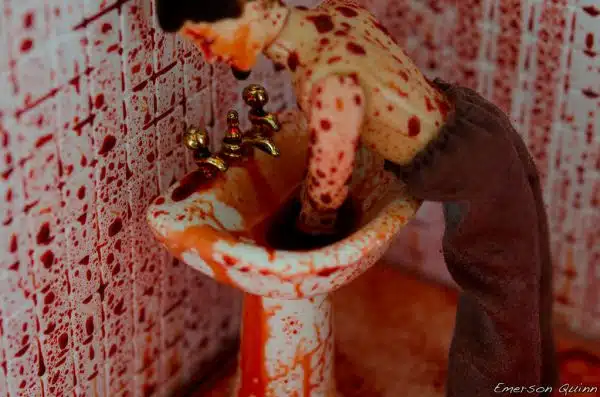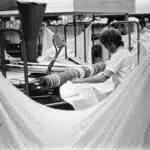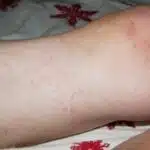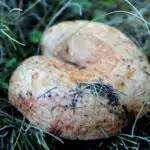As a laundry care expert, I have heard countless stories from people who have faced the challenge of washing blood out of their sheets. Blood stains can be one of the toughest stains to remove, especially if they are not treated immediately. Blood is a protein-based stain that tends to set quickly and become more difficult to remove over time. In this article, we will explore some effective methods for removing blood stains from your sheets, so you can keep them looking fresh and clean.
Removing blood stains requires a combination of patience, knowledge, and the right tools. We will cover some general tips for treating blood stains on sheets, as well as specific techniques for different types of fabrics. By following these steps and using the proper cleaning products, you can remove stubborn blood stains from your sheets and maintain their quality and longevity. Whether you are dealing with a small spot or a larger area affected by bloodstains, this guide will provide you with the knowledge necessary to restore your sheets to their original state.
Understanding The Science Of Blood Stains
Blood stains are a common problem when it comes to laundering sheets. According to a recent study, blood is one of the most difficult stains to remove from fabric, with only 60% of people successfully removing the stain on their first attempt. Understanding the science behind blood stains is crucial in order to effectively eliminate them.
Blood contains proteins that are capable of denaturation, or unfolding, under certain conditions such as exposure to heat or chemicals. This results in the formation of insoluble clumps that adhere tightly to fabric fibers. The longer a blood stain remains untreated, the more likely it is for these proteins to bind permanently with the fabric.
To combat this, it is important to act quickly and use techniques such as soaking and scrubbing. Soaking in cold water can help prevent protein denaturation by preventing heat from activating enzymes that cause it. Scrubbing can help loosen and remove any remaining clumps of protein after soaking. By understanding the chemical reactions at work in blood stains and employing proper washing techniques, you can increase your chances of successfully removing these stubborn stains from your sheets. In order to ensure success in removing blood stains from sheets, immediate treatment is key.
Immediate Treatment Is Key
1.Removing blood stains quickly is essential to prevent damage to fabric; follow the guidelines for the fabric type, as different fabrics require different treatments. 2.For best results, treat the stain immediately; if the stain has dried, soak it in cold water before treating with a laundry detergent designed to remove blood stains. 3.When treating cotton and other natural fabrics, use hydrogen peroxide or ammonia to remove blood stains. 4.For fabrics such as silk, wool and polyester, use a stain remover specifically designed for delicate fabrics. 5.If the stain is still present after treating, repeat the process until the stain is removed. 6.Be sure to keep the stain from settling into the fabric by agitating the fabric during the washing process.
Removing Blood Stains Quickly
Blood stains are a common issue that many people face, especially when it comes to laundry care. Removing blood stains quickly is essential to prevent the stain from setting in and becoming more difficult to remove at a later time. There are several natural remedies and DIY stain removers that can be used to effectively treat blood stains.
One of the most effective natural remedies for removing blood stains is hydrogen peroxide. It is important to act quickly when using this method, as hydrogen peroxide should not be left on fabric for an extended period of time. Simply apply the hydrogen peroxide directly onto the stain and let it sit for a few minutes before washing as usual. Another effective natural remedy is saltwater. Soak the stained fabric in cold saltwater for at least 30 minutes before laundering.
DIY stain removers can also be effective in removing blood stains. One popular option is a mixture of baking soda and water. Make a paste out of these two ingredients and apply it directly onto the stain, allowing it to sit for 15-20 minutes before washing as usual. Another effective DIY stain remover is vinegar and dish soap. Mix equal parts of both ingredients together and apply directly onto the stain, allowing it to sit for 30 minutes before washing as usual.
In conclusion, removing blood stains quickly is essential to prevent them from setting in and becoming more difficult to remove at a later time. Natural remedies such as hydrogen peroxide and saltwater, as well as DIY stain removers like baking soda/water paste and vinegar/dish soap mixture can all effectively treat blood stains on sheets or any other fabric materials with ease.
Treating Different Fabric Types
Understanding fabric types is important when it comes to treating blood stains on sheets. Different fabrics require different treatment methods, and using the wrong method can actually make the stain worse or damage the fabric. Common causes of blood stains on sheets include nosebleeds, menstrual accidents, and accidental cuts or injuries.
For cotton sheets, immediate treatment is essential to prevent the stain from setting in. Hydrogen peroxide and saltwater are both effective options for removing blood stains from cotton. However, for delicate fabrics such as silk or satin, a gentler approach is required. Using hydrogen peroxide or other harsh chemicals can damage these fabrics beyond repair.
When dealing with delicate fabrics, it is best to use a mild detergent and cold water to treat blood stains. Avoid rubbing or scrubbing the stain, as this can cause the fibers to weaken and tear. Instead, gently blot the stain with a clean cloth until it begins to lift. Repeat this process until the stain is gone, then wash as usual using cold water and a mild detergent.
Understanding how to treat different fabric types when it comes to blood stains on sheets can save time and money in the long run. Immediate treatment with gentle yet effective methods can help preserve the integrity of delicate fabrics while ensuring that cotton sheets remain fresh and clean. By following these tips, anyone can successfully remove blood stains from their sheets with ease.
Keeping The Stain From Settling
When it comes to dealing with blood stains on sheets, preventing the stain from settling is crucial. Quick clean up techniques can make all the difference in ensuring that the stain doesn’t become permanent. Immediate treatment is key in this process, as the longer the stain remains on the fabric, the more difficult it becomes to remove.
To prevent blood stains from setting in, it’s important to act quickly. As soon as a stain is noticed, gently blot the affected area with a clean cloth to absorb as much of the blood as possible. Avoid rubbing or scrubbing, as this can push the stain deeper into the fibers of the fabric and make it harder to remove.
Once you’ve blotted away excess blood, treat the stain using appropriate methods for your specific type of fabric. The goal is to lift away any remaining residue without causing damage to delicate fabrics or discoloration on cotton sheets. Following these steps can help keep your linens looking fresh and clean while preventing blood stains from becoming a permanent fixture.
Pre-Treating Blood Stains With Enzymatic Cleaners
Immediate treatment is key when it comes to removing blood stains from sheets. The longer the stain sits, the harder it becomes to remove, and it may even set into the fabric permanently. To prevent this, start by soaking the affected area in cold water for at least 30 minutes. This will help to loosen the stain and make it easier to remove.
After immediate treatment, pre-treating blood stains with enzymatic cleaners can be an effective way to completely remove any remaining traces of blood. Enzymatic cleaners are designed specifically to break down organic materials, such as blood, and are highly effective at removing these types of stains from fabrics. When using enzymatic cleaners, it is important to follow the manufacturer’s instructions carefully in order to ensure maximum effectiveness.
If you do not have access to enzymatic cleaners or prefer alternative pre-treatment methods, there are other options available. For example, some people recommend using a paste made from baking soda and water to pre-treat blood stains on sheets. Simply mix enough baking soda and water together to form a paste-like consistency, apply it directly to the stain, and let it sit for several hours before washing as normal. Alternatively, vinegar can also be used as a pre-treatment method for blood stains on sheets.
In summary, enzymatic cleaner effectiveness is well-established for removing blood stains from sheets after immediate treatment has taken place. However, if you prefer not to use an enzymatic cleaner or do not have one available, there are alternative pre-treatment methods that can be just as effective. Whether you choose an enzymatic cleaner or an alternative method like baking soda or vinegar paste, taking the time to pre-treat blood stains before washing your sheets can save you time and effort in the long run by ensuring that your sheets come out looking clean and fresh every time. Next up we will discuss using hydrogen peroxide to remove blood stains from sheets effectively.
Using Hydrogen Peroxide To Remove Blood Stains
Blood stains on sheets can be a real hassle to remove, but there are various methods that can be used to get rid of them. One popular method is using hydrogen peroxide. This solution works by breaking down the proteins in the blood and lifting it from the fabric.
To use this method, start by removing as much of the excess blood as possible by blotting with a clean towel or cloth. Next, pour hydrogen peroxide onto the stain and let it sit for a few minutes. Then, rinse with cold water and repeat until the stain disappears. It’s important to note that hydrogen peroxide may bleach colored fabrics, so it’s recommended to test a small area first.
If you prefer alternative methods for removing blood stains from sheets, there are other options available as well. Baking soda is one such alternative that can be effective at lifting stains. Simply mix baking soda with water to create a paste and apply it directly to the stain. Allow the paste to dry completely before brushing off and washing as usual.
Another alternative is vinegar. Mix equal parts white vinegar and water and apply directly onto the stain. Let it sit for 30 minutes before rinsing with cold water and washing as usual.
Now that you know how to use hydrogen peroxide, baking soda, and vinegar to remove blood stains from sheets, let’s move on to another common fabric: cotton sheets.
Removing Blood Stains From Cotton Sheets
After using hydrogen peroxide to remove blood stains from your sheets, it is important to properly wash and dry them. For cotton sheets, the best method is to use cold water and a mild detergent. Avoid using hot water as this can set the stain permanently. It is also recommended to pre-treat any remaining stains with a laundry stain remover before washing.
If the DIY remedies do not work, or if you are dealing with particularly stubborn blood stains on your cotton sheets, it may be best to seek professional services. There are many laundry services that specialize in stain removal and can help get your sheets looking like new again.
When it comes to removing blood stains from polyester sheets, the process is slightly different than with cotton. Polyester is more resistant to staining but can still be prone to discoloration if not treated properly. The first step is always to act quickly and blot up as much of the blood as possible before applying any cleaning solution. From there, you can use a combination of cold water and a mild detergent or opt for a specialized stain remover designed specifically for polyester fabrics.
Removing Blood Stains From Polyester Sheets
As the saying goes, prevention is better than cure. When it comes to polyester sheet cleaning hacks, the best way to remove blood stains from sheets is to address them as soon as possible. The longer the stain sits, the harder it will be to remove. So, if you notice a blood stain on your polyester sheets, act fast and follow these natural remedies for blood stain removal on sheets.
Firstly, blot the stain with a clean cloth or paper towel to remove as much blood as possible. Avoid rubbing or scrubbing too hard as this can spread the stain and damage your sheets. Once you’ve blotted away most of the blood, apply cold water directly to the stain and let it soak for at least 30 minutes. Avoid using warm or hot water as this can cause the stain to set in.
Next, mix a solution of equal parts hydrogen peroxide and dish soap in a spray bottle. Spray this mixture onto the stained area and let it sit for 10-15 minutes before washing your sheets in cold water. If the stain persists after washing, repeat this process until it disappears completely.
In conclusion we have looked at some effective natural remedies for removing blood stains from polyester sheets; acting fast, applying cold water and using a hydrogen peroxide and dish soap mixture are all great ways to tackle those pesky stains head on. But what about when you’re dealing with silk sheets? Don’t worry – we’ve got you covered with our next section on removing blood stains from silk sheets.
Removing Blood Stains From Silk Sheets
To continue our discussion on removing blood stains from different types of sheets, let’s move on to silk sheet care. Silk is a delicate fabric that requires gentle handling to maintain its softness and luster. When dealing with blood stains on silk sheets, it’s important to avoid using hot water or harsh detergents that can damage the fabric.
To begin the stain removal process, gently blot the blood stain with a clean cloth or paper towel to absorb as much of the blood as possible. Then, follow these stain prevention techniques:
- Mix cold water with a mild detergent and apply it directly to the stain.
- Gently rub the fabric together to work the detergent into the fibers.
- Rinse thoroughly with cold water until all traces of soap have been removed.
If the stain persists after this initial treatment, try applying a mixture of cold water and vinegar directly to the affected area before repeating steps 2 and 3 above.
Silk sheet care involves being diligent about preventing stains before they happen. Consider using a mattress protector or investing in high-quality sheets that are less likely to become damaged or stained over time. With proper care, your silk sheets will last for years and remain beautiful and luxurious even after multiple washings.
Moving onto our next topic, we’ll discuss removing blood stains from linen sheets using similar techniques for gentle yet effective stain removal.
Removing Blood Stains From Linen Sheets
When it comes to washing linen sheets, one of the most common issues is removing blood stains. While accidents happen, it’s important to take care of these stains as soon as possible to prevent them from setting in permanently. Luckily, there are several DIY methods that can help remove blood stains from linen sheets.
Firstly, it’s important to address the stain as soon as possible. Use cold water and a clean cloth to blot the stain gently, avoiding rubbing or scrubbing which can push the stain further into the fabric. If the stain has already dried, you can try soaking the sheet in cold water with a small amount of laundry detergent for 30 minutes before washing as usual. For tougher stains, try mixing hydrogen peroxide and baking soda into a paste and applying it directly to the stain before washing.
While DIY methods can be effective for removing blood stains from linen sheets, sometimes professional services may be necessary. A professional cleaner will have access to stronger cleaning agents and equipment that can remove even the most stubborn stains without damaging your sheets. It’s important to note that using harsh chemicals or bleach at home can damage your sheets’ fibers and cause discoloration over time.
In summary, removing blood stains from linen sheets requires prompt action using gentle blotting techniques with cold water before attempting DIY methods such as hydrogen peroxide and baking soda paste. However, if these methods fail or if you’re dealing with particularly stubborn or delicate stains, it may be best to seek out professional cleaning services for optimal results without causing damage to your precious linens. In our next section, we’ll discuss how to remove blood stains from microfiber sheets using similar techniques but with slight adjustments due to their unique fabric composition.
Removing Blood Stains From Microfiber Sheets
Microfiber sheets are a popular bedding choice due to their softness and durability. However, they can easily become stained, especially with blood. If you find yourself with a blood stain on your microfiber sheets, there are several stain removal hacks that you can try.
Firstly, it is important to act quickly when dealing with blood stains. The longer the stain sits, the harder it will be to remove. Begin by soaking the affected area in cold water for at least 30 minutes. Avoid using hot water as this can set the stain permanently.
Next, choose the right detergent for your microfiber sheets. Look for a detergent that is specifically formulated for removing tough stains like blood. Avoid using bleach or other harsh chemicals as these can damage your sheets and cause discoloration. Follow the instructions on the detergent bottle carefully and wash your sheets in cold water to prevent further setting of stains.
Transition: While these steps work well for fresh blood stains, removing old blood stains requires a different approach. Read on to learn how to tackle stubborn stains that have been sitting for a while.
Removing Old Blood Stains
Old blood stains on sheets can be particularly challenging to remove. The longer the stain sets, the more difficult it becomes to get rid of it completely. However, there are effective methods to remove old blood stains from sheets without damaging the fabric.
The first step in removing an old blood stain is to soak the sheet in cold water for at least 30 minutes. If the stain is still visible after soaking, apply a small amount of enzyme-based laundry detergent directly onto the stain and let it sit for 15-20 minutes before washing. For tougher stains, you may need to repeat this process several times until the stain disappears entirely.
Alternative methods and home remedies can also be used to remove old bloodstains from sheets. One such remedy involves mixing equal parts hydrogen peroxide and liquid dish soap and applying it directly onto the stained area. Let it sit for 5-10 minutes before rinsing with cold water and washing as usual. Another alternative method involves using a mixture of baking soda and water to create a paste that can be applied directly onto the stain before washing.
In summary, removing old blood stains from sheets requires patience and persistence. Soaking in cold water followed by enzyme-based laundry detergent is often effective for mild stains, but tougher stains may require alternative methods or home remedies such as hydrogen peroxide or baking soda paste. With these tips, you can restore your sheets to their original clean state without having to replace them.
Moving forward, preventing bloodstains on sheets is essential in maintaining their cleanliness and longevity. Here are some tips on how to prevent future stains: – Avoid eating or drinking in bed, especially messy or staining foods and beverages.
Tips For Preventing Blood Stains On Sheets
Preventing stains on your sheets is an important aspect of bedding hygiene. While it can be challenging to keep your sheets clean, there are a few tips that you can follow to prevent blood stains from appearing. First and foremost, make sure to address any cuts or injuries promptly. Applying pressure and cleaning the wound immediately will help reduce the likelihood of blood getting onto your sheets.
Another tip for preventing blood stains is to avoid eating or drinking in bed. This may seem like a no-brainer, but spills can happen easily, and once they do, it can be tough to get them out of your bedding. Additionally, make sure to wash your sheets regularly. Dirty sheets are more likely to retain stains than clean ones.
In addition to these preventative measures, it’s essential to know how to care for your sheets properly when they do become stained. One common mistake people make is washing their sheets in hot water. This can set the stain in further and make it even more difficult to remove. Instead, opt for cold or lukewarm water when washing blood-stained sheets. In the next section, we’ll discuss why hot water should be avoided when trying to remove stubborn stains from your bedding.
Don’t Use Hot Water
- Color bleeding is a common issue when washing sheets with blood, and hot water can exacerbate this issue.
- To prevent color bleeding, choose a detergent specifically designed for colorfast fabrics and use the gentle cycle, cold water setting for best results.
- Overloading the washing machine with detergent, or using too much detergent, can cause color bleeding on the sheets, so it’s important to use the recommended amount of detergent that is appropriate for the load size.
- Additionally, adding a cup of white vinegar with the detergent can help prevent color bleeding and preserve the life of your sheets.
Color Bleeding
As a laundry care expert, it is essential to understand bloodstain patterns and how to treat deep set blood stains. One common mistake people make when trying to wash blood out of sheets is using hot water. This can actually make the stain worse by setting it deeper into the fabric.
Color bleeding occurs when the dye from one fabric transfers onto another during washing. Using hot water increases the chances of color bleeding, especially if you are washing sheets with other clothing items. If color bleeding does occur, it can be difficult to remove without damaging the fabric. Therefore, it is crucial to avoid using hot water when trying to wash blood out of sheets.
Instead, opt for cold water and a gentle detergent specifically designed for removing tough stains like blood. Soak the stained area in the solution before washing as usual. For deep set blood stains, pre-treat with an enzyme-based stain remover before washing. By following these tips and avoiding hot water, you can effectively wash blood out of sheets without causing further damage or color bleeding.
Detergent Overload
As a laundry care expert, it is important to understand the impact of detergent overload on your sheets. Using too much detergent can cause residue buildup, leading to dingy and stiff sheets. This can also lead to skin irritation and allergies for sensitive individuals. Preventing detergent overload is crucial in maintaining the quality of your sheets.
Proper detergent usage involves using the recommended amount based on the size of your load and water hardness level. It is also essential to choose a detergent that is suitable for your fabric type and stain level. For example, using a high-efficiency (HE) detergent for HE washing machines or selecting a gentle detergent for delicate fabrics like silk or wool.
By following these guidelines, you can prevent detergent overload and ensure your sheets are clean and fresh without causing damage or skin irritation. Properly measuring your detergent and selecting the right product will not only protect your sheets but also extend their lifespan, saving you money in the long run. As a laundry care expert, it is my duty to educate others on proper detergent usage to serve their needs effectively.
Drying Your Sheets After Removing Blood Stains
After successfully removing blood stains from your sheets, it is important to ensure that they are properly dried. Drying your sheets improperly can cause them to shrink or become misshapen, which can lead to discomfort when sleeping. Therefore, we have put together a guide on how to dry your sheets effectively without causing any damage.
Firstly, you should avoid using high heat settings in the dryer when drying your sheets as this can cause them to shrink. Instead, opt for a low heat setting and remove them from the dryer while they are still slightly damp. This will help prevent over-drying and reduce the risk of shrinking.
Secondly, it is important to use a fabric softener when washing your sheets after removing blood stains. This will help keep them soft and smooth, making them more comfortable to sleep on. Some of the best fabric softeners for post stain washing include Downy April Fresh Fabric Softener and Snuggle Plus Super Fresh Liquid Fabric Softener.
Finally, once you have removed your sheets from the dryer, you should fold them neatly and store them in a dry place. Avoid leaving them in direct sunlight or damp areas as this can cause mildew growth and damage the fabric.
- How to dry sheets without shrinking
- Best fabric softeners for post stain washing
- Tips on folding and storing your sheets correctly
- Common mistakes people make when drying their sheets
- Benefits of air-drying over machine drying
Now that you know how to properly dry your freshly cleaned sheets, it’s important to note that there may be instances where seeking professional help is necessary. In the next section, we will discuss when it’s time to reach out for assistance with stubborn stains or other laundry-related issues.
When To Seek Professional Help
After drying your sheets, it is important to inspect them for any remaining blood stains. Dealing with stubborn blood stains may require more than just soap and water. If the stain persists after washing, do not panic as there are several other methods you can try.
However, if none of these methods seem to work, it may be time to seek professional help. Professional cleaners have access to stronger cleaning agents and equipment that can effectively remove tough stains without damaging the fabric. Additionally, they may also be able to offer advice on how to prevent future stains from occurring.
Remember that maintaining the quality of your sheets is key in ensuring their longevity. Preventing stains before they occur is always the best option. In addition to regular washing and stain removal practices, consider investing in high-quality bed linens that are easier to maintain and less likely to absorb stains. By taking proper care of your sheets, you can ensure a comfortable and clean sleeping environment for years to come.
Maintaining The Quality Of Your Sheets
Maintaining sheet quality is essential for ensuring a restful night’s sleep. Proper care and attention can prolong the life of your sheets, keeping them soft, comfortable, and free from wear and tear. To achieve this, it is important to follow some basic rules. Firstly, wash your sheets regularly to prevent the build-up of dirt and bacteria that can cause unpleasant odors. Secondly, avoid using harsh chemicals such as bleach or fabric softeners that can damage the fibers and reduce their lifespan.
Blood stain prevention strategies are also crucial when it comes to maintaining sheet quality. Accidents happen, but knowing how to deal with them quickly and effectively can minimize the damage caused. If you have a bloodstain on your sheets, rinse it under cold water as soon as possible before washing it in cool water with a mild detergent. Hot water can set the stain permanently into the fibers, making it much harder to remove.
Incorporating these strategies into your laundry routine will help keep your sheets looking and feeling their best for longer. By following these simple steps, you can ensure that you always have fresh, clean bedding to snuggle up in at night. Remember that investing a little time and effort now will pay dividends in terms of comfort and convenience further down the line.
Conclusion
Blood stains on sheets can be frustrating and difficult to remove. Understanding the science behind blood stains is crucial when it comes to treating them effectively. Immediate treatment is key, as dried blood stains are much harder to remove than fresh ones.
Pre-treating blood stains with enzymatic cleaners can break down the proteins in the blood, making it easier to remove. Hydrogen peroxide is also effective in removing blood stains from sheets, but caution must be taken as it can bleach certain fabrics. When removing blood stains from cotton sheets, avoid using hot water as this can set the stain in permanently.
After successfully removing the stain, ensure that your sheets are properly dried before using them again. If all else fails, seek professional help for stubborn or set-in stains. By maintaining the quality of your sheets through proper care and attention, you can extend their lifespan and keep them looking fresh for longer.
As a laundry care expert, I recommend remembering the adage “an ounce of prevention is worth a pound of cure.” Taking immediate action when dealing with blood stains on sheets can save time and effort in the long run. By following these steps and taking proper care of your sheets, you can enjoy a restful night’s sleep without worrying about stubborn stains.
Image Credits
- “Killer doll washes blood off his hands” by emersonquinn (featured)





























